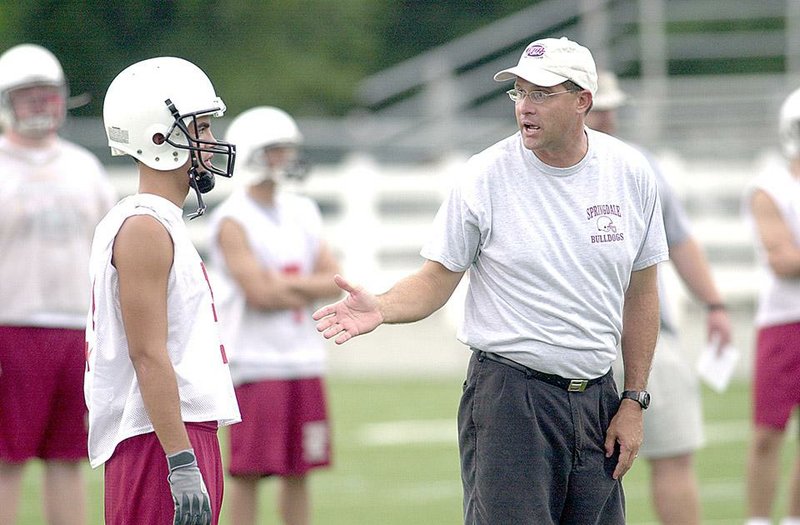Trickle up instead of trickle down?
That abnormality is underway mostly in the world of technology, where young people are teaching geezers like myself the basic skills on how to navigate computers and smart phones. It is an ongoing process that can be frustrating, especially to a generation that grew up with typewriters and telephones that needed an outlet.
It became clear last week the same process is happening in football where old, established ideas are being replaced by a new way of thinking. Chad Morris, a left-lane proponent of the spread offense, said as much when he took the stage for the first time as the football coach at Arkansas.
“Businesses aren’t run like they used to and it changes every year,” Morris said while speaking frequently about his roots as a high school coach. “What you’ve seen in football in the last eight or nine years is a trickle-up effect from the high schools. High school coaches are so innovated and they have to structure their schemes around the players that they have. They have to think outside the box. So, what you find is a trickle-up effect that goes from high school to college and you’re seeing some of the same things being done in the NFL.”
The fast-paced, wide-open philosophy is more acceptable today than in 1997 when I watched Barry Lunney Sr. take a team that had finished 1-9 the previous year, put them in the spread offense and lead Fort Smith Southside to the state championship. Gus Malzahn was doing the same thing at Shiloh Christian and Springdale High School, then he was hired as Arkansas’ offensive coordinator after leading the Bulldogs to a 14-0 record in 2005.
I can’t remember what was said at Malzahn’s introductory press conference that day, but I do remember seeing three or four of Houston Nutt’s assistants walking away from the Broyles Center. Their body language and mumbling suggested strongly the disbelief a coach straight from Springdale High was joining the staff.
“High school,” is what Malzahn was supposedly called by one or more of the Arkansas assistants before he bolted after one year for Tulsa.
Like Malzahn, Morris also met resistance during his transition from a highly successful high school coach to an assistant and then a head coach on the college level. The two friends are now SEC head coaches while those former Arkansas assistants are candidates for the “Where are they now?” segments that appear in this newspaper on occasion.
The Malzahn-Morris approach is the norm for area high school coaches like Rick Jones of Greenwood and Billy Dawson of Fayetteville, who’ve each won multiple state championships using the spread offense.
“It’s very exciting to have a coach at the University of Arkansas, who shares similar philosophies,” Jones said. “Instead of going to Auburn, Atlanta, or Tulsa like we’ve done in the past, we can drive 60 minutes up here to talk and learn things.”
So, a new philosophy is in place at Arkansas where the offense will force the opposition to defend every inch of a 100-yard field instead of trying to outmuscle people at the line of scrimmage. It’s an exciting brand of football, and the honeymoon with Morris will last until the Razorbacks score 45 points and lose when their opponent scores 46 or more.
Now for a few words on Malzahn, the former Hughes, Shiloh Christian, Springdale High and Arkansas assistant who was Plan A in the Razorbacks’ coaching search.
I refuse to believe Malzahn used the Razorbacks or turned his back on his home state for financial gain as the jilted have claimed. Malzahn was not obligated to come home and clean up the mess, especially when he wasn’t even considered five years ago when Bret Bielema was hired instead. Malzahn’s decision to stay at Auburn has more to do with trying to win a national championship than adding millions to his bank account.
In case you’ve forgotten, Malzahn traded a job that paid $1.3 million as an offensive coordinator at Auburn for his first head coaching job at Arkansas State that paid him $850,000. It was part of his plan and the move surprised everyone, including Arkansas State Athletic Director Terry Mohajir, who initially called Malzahn to ask for a recommendation on the vacancy.
So, here we are with Morris, Plan B.
To the pessimistic or unconvinced, I hope you agree Morris, 49, is a man who has paid his dues and deserves his opportunity on the big stage. So, let’s trickle up and get down with those fast-paced, funky Razorbacks starting in 2018.
Should be fun. Can’t be any worse.
Rick Fires can be reached at rfires@nwadg.com or on Twitter @ NWARick.
